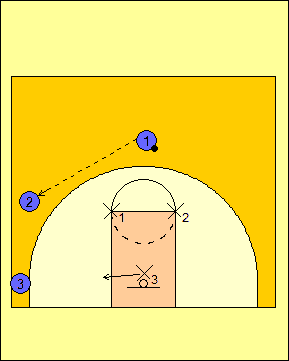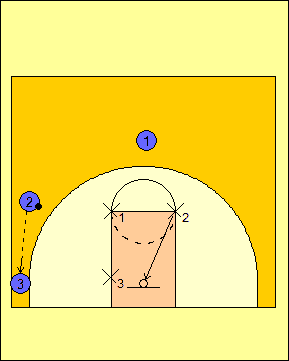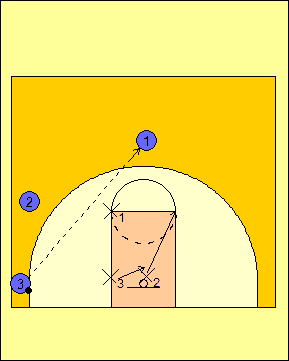|
JUNK DEFENSES
In a number of games, a situation arises where the
opposing has one or two players who are dominant and you cannot afford
to be beaten by these players. At this time, the use of a junk
defense would probably be appropriate. A junk defense is a
combination of a certain number of players playing man-to-man defense on
the other team's best offensive players while the remaining players play
a particular zone defense.
Advantage of Junk Defenses
The biggest advantage of any junk defense is that it limits the offensive
potency of outstanding offensive players. Many times, a team will have the
unenviable task of having to guard an outstanding player that this will make the
most sense. It makes even more sense when a team that you are playing has
one or two great offensive players and the remaining offensive players are
mediocre at best.
Disadvantage of Junk Defenses
There is an old expression that goes along the lines of "the operation was a
success but the patient died". In basketball, that means that you were
successful in limiting the scoring ability of a great offensive player, but you
lost the game. Understand that you put your team at risk to lose by
employing a junk defense if the remaining players on the opposing team get out
of hand and have big games scoring. Enough of these players will get you
and your team beat.
Setting Up the Defense
When setting up the defense, you will need to realize
that a certain number of players will be playing man-to-man defense.
To make this defense work, you must select the best defenders who can
cover the other team's best offensive players. They will be the
ones playing man-to-man defense and they will have to cover those
players. If those offensive players do not have the ball, their
defenders must always play to deny them the basketball so as to reduce,
if not eliminate, their offensive touches.
You will also need to determine who are your best interior defenders and who you
have to have to rebound. This will enable you to have a decided advantage
when the other team (hopefully those who are not the skilled offensive players
you are guarding man-to-man) misses a shot. This will also help in
determining what kind of zone you intend to play in the junk defense as well.
Diamond and One
The first defense is the Diamond and One. The
Diamond and One is designed for a team that likes to play an odd-guard
front offense and has one player on the offense who is an outstanding
scorer. To set up the zone, your players need to align themselves
in a diamond formation with the point of the zone at the nail, two
players on the lane line halfway between the free throw line and the
backboard, and a player just in front of the front of the rim (Diagram
1).
To run the zone, your players must know how to cover the
lane area. If the ball is passed below the wing, the top man in
the zone must cover the ball-side elbow and the player starting on the
ball-side lane line must front the low post (Diagram 2). If the
ball is passed from guard-to-guard, the top of the zone must cover the
ball-side elbow and prevent the penetrating pass (Diagram 3). From
here, a pass below the wing can be made which makes the player on the
ball-side lane line front the low post (Diagram 4).
Box and One
By far, the most popular junk defense has to be the Box
and One defense. This defense features four players playing a box
zone with the one remaining player playing man-to-man defense. The
set-up for the Box and One defense has two players at the elbows and two
players on the low blocks to start (Diagram 5). When the ball is
passed to the wing, the defense stays stationary (Diagram 6).
However, when the ball is passed to the corner, the zone
goes into action with the ball-side low block player fronting the low
post, the help-side low block player protecting the basket, and the
player starting at the help-side elbow moving to the nail (Diagram 7).
Diagram 8 shows the zone on a skip pass from the corner and the zone
resetting to its original box alignment.
|

Diagram 5 |

Diagram 6 |
|

Diagram 7 |

Diagram 8 |
Triangle and Two
Perhaps the second-most popular or well-known junk
defense is the Triangle and Two. The Triangle and Two features
three players playing in a zone with the two remaining players playing
man-to-man defense. The zone has one player at the nail and the
two remaining players on the low blocks to start (Diagram 9).
Diagram 10 shows the Triangle and Two initiated by a
guard-to-guard pass. When this happens, the player playing on the
top of the zone must cover the ball-side elbow.
In Diagram 11, the ball is passed to the corner.
The ball-side low post fronts the low post while the help-side low post
protects the basket.
Finally, Diagram 12 shows how to guard against the skip
pass from the corner. The two bottom players return to their
initial starting spots while the player on the top of the zone covers
the opposite elbow which is now the ball-side elbow.
Inverted Triangle and Two
The variation of the Triangle and Two Defense is the Inverted Triangle and Two
Defense. This defense sets up with two players on the elbows and one
player just in front of the front of the rim (Diagram 13).
The zone goes into action when the ball is passed from the point to the wing.
When this pass is made, the player at the bottom of the zone protects the
ball-side low post area (Diagram 14).
On the pass to the corner, the player who started help-side elbow will move to
the front of the rim to protect the basket (Diagram 15). An adjustment can
be made for a slower player to move to a point midway between the elbow and the
front of the rim if needed.
Diagram 16 shows the ball being passed from the corner back to the point.
On this pass, the players get back into their original positions as they were
shown to be in Diagram 13.
|

Diagram 13 |

Diagram 14 |
|

Diagram 15 |

Diagram 16 |
Three and a Stack
Three and a Stack is a defense that was presented to me by my mentor Larry
Holley when I was a student manager at William Jewell College. If you are
facing a team with three outstanding offensive players and two mediocre ones,
this defense might work though its use is rare if ever used.
The zone sets up with the top player at the nail while the other player sets up
just in front of the front of the rim (Diagram 17). Diagrams 18 and 19
detail the zone coverage. Whichever side of the floor the ball is on, the
top player will guard the ball-side elbow and the player in front of the front
of the rim will front the ball-side low post.
Four and a Spot
One defense that can be run if a team wants to take advantage of a great post
defender who a team does not want to guard outside of the post is the
four-and-a-spot defense. This defense places X5 under the basket and the
remaining four players playing man-to-man defense. We will always leave
the weakest offensive player unguarded and force him to beat us. The only
defensive responsibility that X5 will have is to provide help to any dribble
penetration to the rim.
Teaching Junk Defenses
When teaching any junk or combination defense, you need to practice it whole
method to an extent. During your shell work, you can practice the zone
with the set number of defenders playing the zone portion of the defense.
The shell work is designed to help you work on the slides of the four-man,
three-man and two-man zones to reinforce the idea of protecting the high and low
post areas.
RETURN TO MEMBERSHIP AREA
© 2010-2017 Alan Peel Enterprises
|